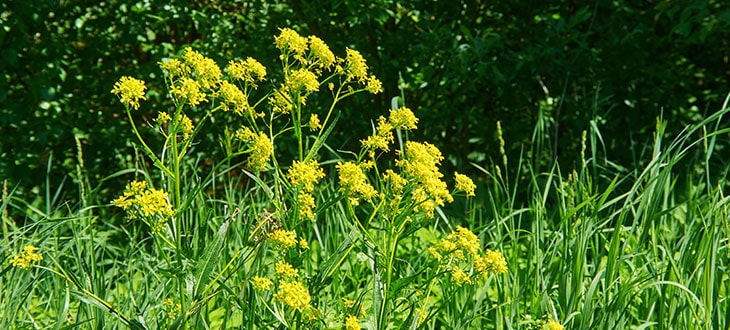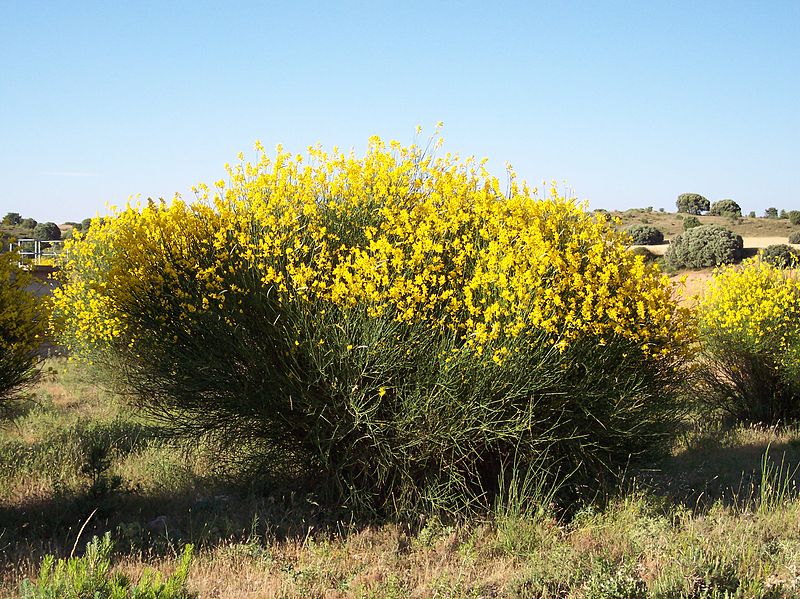10 Tall Weeds With Yellow Flowers
Did you find tall weeds with thick stalks in your yard or garden and need help identifying them? Below is a list of plant species with these characteristics.
Plants have various spreading mechanisms. Sometimes their seeds are carried by the wind, other times by insects, birds, or animals. So, it is not surprising that new plants can appear even where we least expect them.
Weeds especially can multiply rapidly and can cover large areas quickly.
Today we will talk about some of the weeds that grow tall and produce yellow blossoms. Hence, the next time you find an unknown plant that has these particularities, you should be able to easily recognize it.
Contents
- 1. Wintercress (Barbarea Vulgaris)
- 2. Butterweed (Packera Glabella)
- 3. Ragwort (Jacobaea Vulgaris)
- 4. Garden Loosestrife (Lysimachia Vulgaris)
- 5. Spanish Broom (Spartium Junceum)
- 6. St. John’s Wort (Hypericum Perforatum)
- 7. Skeletonweed (Chondrilla Juncea)
- 8. Sow Thistle (Sonchus Arvensis)
- 9. Grass-leaved Goldenrod (Euthamia graminifolia)
- 10. Yellow Toadflax (Linaria Vulgaris)
1. Wintercress (Barbarea Vulgaris)

Barbarea vulgaris, popularly known as wintercress, yellow rocketcress, along several other names, is a biennial weed native to Eurasia and North Africa.
Wintercress is a moderately tall plant that may reach a maximum height of 24 to 32 inches (60-80 cm). It is a well-adapted weed and can grow anywhere from roadsides to hay fields, waste ground, rocky outcrops, stony slopes, and more.
The first year it produces a rosette of basal leaves, while the second year will grow upright stalks that end with dense clusters of small yellow flowers. The flowers have four petals and are lightly fragrant. Its flowering period usually lasts from April to July.
The leaves are green, pinnately-lobed to deeply-toothed. The lower ones have a large, rounded end lobe and 1 to 4 pairs of smaller lateral lobes. The leaves growing on the stalk progressively get smaller towards the top and have an almost oval shape. (source)
Wintercress produces small elongated green fruits which carry many tiny seeds.
2. Butterweed (Packera Glabella)

Packera glabella is an annual weed native to central and southeastern North America. It is often known as butterweed, cressleaf groundsel, or yellowtop.
Butterweed is frequently found growing in large groups in places with high humidity, including agricultural fields, near ponds, swamps, forests, stream banks, roadsides, etc.
In the early stages, Packera glabella develops a low rosette of basal leaves, and during the spring, it raises a hollow stalk that terminates with a cluster of yellow, daisy-like flowers. Its blooming period usually extends from April to June.
The leaves are green, alternate, either simple-pinnate or deeply pinnatifid, with a larger terminal leaflet and smaller lateral leaflets. (source)
The foliage and other parts of butterweed are known to contain alkaloids. These compounds are toxic if ingested and can cause liver damage in herbivores.
During flowering, the plant can reach a height of about 3 ft (90 cm).
3. Ragwort (Jacobaea Vulgaris)

Jacobaea vulgaris is a common wildflower indigenous to northern Eurasia. It usually grows in open and dry regions such as pastures, trails, and along roadsides.
Some of the common names of this plant include ragwort, common ragwort, Jacobaea, or tansy ragwort.
Although ragwort is considered a wildflower in some areas, it is also considered a noxious weed in other regions due to its invasive nature. To its bad reputation also contributes the fact that it contains toxic compounds that can sicken the livestock.
However, ragwort also plays a significant role in the production of nectar, which feeds many species of pollinating insects. Throughout the season, a single plant can produce up to 2,500 flowers.
In its early stages, a jacobaea vulgaris plant emerges as basal rosettes with ruffled leaves. Later, they develop upright stems, that can reach a height of up to 2 meters.
The leaves are pinnately lobed and the end lobe is blunt. They also have a distinctively unpleasant odor.
Jacobaea vulgaris has a long blooming period and produces yellow flowers that grow in dense clusters in the upper part of the plant.
4. Garden Loosestrife (Lysimachia Vulgaris)

Lysimachia Vulgaris is a species of perennial plants native to southeast Europe. It is also commonly known as garden loosestrife or yellow loosestrife.
Garden Loosestrife is a tall plant and can grow up to 78 inches (2 m) in height. It thrives in moist environments, such as shorelines, wetlands, and streambanks.
Although when it blooms it offers a pleasant view, garden loosestrife it is sometimes regarded as an invasive plant due to its aggressive way of spreading by rhizomes, and thus, creating very dense populations.
During summer, lysimachia vulgaris produces clusters of yellow flowers at the top of its upright and hairy stems.
The leaves are dark-green, lance-shaped, present soft hairs, and grow along the stalk.
5. Spanish Broom (Spartium Junceum)
Spartium Junceum is a perennial shrub species native to the Mediterranean in southern Europe, southwest Asia, and northwest Africa. It is popularly known as Spanish broom or rush broom.
Spanish broom is used as an ornamental plant in several regions of the world with a Mediterranean climate. However, in some areas, it has managed to propagate uncontrollably and has thus been introduced on the list of noxious invasive species.
Spartium junceum usually reaches up to 13 ft (4 m) in height and is frequently found on roadsides, grasslands, and wetlands.
It has thin cylindrical long stems with few branches which are green and soft when young and become woody branches at maturity. Its leaves are green, tiny, elongated, oval, and have smooth edges.
In late spring and early summer, the Spanish Brooms produce a multitude of fragrant yellow pea-like flowers that grow on short stalks on both sides of the main stem. (source)
6. St. John’s Wort (Hypericum Perforatum)

Hypericum perforatum is a perennial weed that grows in many temperate regions throughout the world, including parts of Eurasia, North and South America, Australia, and South Africa.
St. John’s Wort has been used for decades in natural treatments for depression, anxiety, burns, and wounds and is also considered a plant that can ward off evil spirits. However, due to its aggressive way of propagation and because it’s toxic for livestock when ingested, this plant was included in the noxious weeds list of many regions.
This plant can grow up to 3.3 ft (1m) high, has upright reddish stems which are branched in the upper part. Its leaves are yellow-green with scattered translucent dots, narrow with an oval to oblong shape that end with rounded tips. The leaves also and don’t possess leaf stalks.
Between late spring and early to mid-summer, St. John’s Wort produces bright yellow with noticeable black dots. These form clusters of several flowers and emerge on the top of the upper stems. Each flower has five yellow petals with black dots scattered on its surface and a group of yellow stamens in the center.
7. Skeletonweed (Chondrilla Juncea)

Chondrilla juncea is a weed indigenous to Europe, Asia, and North Africa, but introduced to most temperate regions of the world. In addition to its scientific name, Chondrilla Juncea is popularly known by names such as skeletonweed, devil’s grass, gum succory, or nakedweed.
The plant starts as a basal rosette of leaves in its early stages, during which it can easily be mistaken with dandelions. Later, it develops one flowering stem which branches greatly. The stems are usually leafless and, when leaves are present, are very tiny.
Skeletonweed is considered a troublesome weed in many areas as it quickly invades agricultural fields and battles with other plants for water and nutrients. A mature plant can grow pretty tall, reaching up to 60 inches (1.5m) in height. (source)
The stems, leaves, and roots of chondrilla juncea plants discharge a milky latex when cut.
Along or at the tops of stems, the plant will produce small daisy-like yellow flowers from summer to fall.
8. Sow Thistle (Sonchus Arvensis)

Sonchus arvensis is a perennial weed in the daisy family native to Europe, but over the years, it was introduced to many other areas throughout the globe. It is popularly known under many names, including field milk thistle, field sowthistle, corn sow thistle, gutweed, swine thistle, etc.
Sow thistle is a very adaptable plant and can be observed in a wide range of environments, including cultivated fields, disturbed areas, lawns, meadows, along roadsides, marshes, woods, beaches, and lakes and river shores. (source)
Sonchus arvensis is regarded as an invasive noxious weed in many countries as it frequently emerges in annual crop fields, causing substantial yield losses.
This plant is most easy to identify during flowering when it produces yellow flowers almost identical to dandelion. This is also the reason why these two are often mistaken. However, there are several differences between a dandelion and a sow thistle which are easy to spot, especially in a well-developed plant. These include the shape of the leaves, the presence of a robust stem, and the height of the plant.
Sow thistle can grow up to 5 feet (1.5 m) or more (4 ft 11 in) in height. The leaves are green, large, grow alternate the stem, can be lobed or unlobed, and may present spines. The stems and leaves emit a milky sap when cut.
9. Grass-leaved Goldenrod (Euthamia graminifolia)

Euthamia graminifolia is a perennial weed native to North America which was later introduced to regions of Europe and Asia. Other common names for this plant are grass-leaved goldenrod and flat-top goldentop.
It has a long and thin stem, more or less branched, varying from one plant to another. Although not very robust, this plant can grow quite tall, reaching heights of up to 4 feet (1.2 m).
Leaves are green, simple, long, and grow alternately along the stem.
During it blooming period, which usually lasts from late summer to early fall, euthamia graminifolia produces clusters of tiny small flowers at the top of the plant and many of the upper side stems. The flowers usually bloom gradually, extending the plant’s blooming period.
10. Yellow Toadflax (Linaria Vulgaris)

Linaria vulgaris is a species of perennial flowering plants, native to Europe, Central Asia, and Siberia but which have also been introduced to North America. It is also known as common toadflax, yellow toadflax, or butter-and-eggs.
Yellow toadflax thrives on disturbed and cultivated land and along roads. While it is regularly found as a wildflower, it is occasionally cultivated for cut flowers as it lasts a long time in the vase. However, due to its aggressive mode of propagation, it is recommended to use it only with caution for this purpose.
From mid-summer to mid-autumn, linaria vulgaris produces pale yellow flowers.
Although it does not reach very impressive sizes, Linaria vulgaris can reach up to 34 inches (90 cm) in height.
Final Word
There is an abundance of wild weed species that grow tall and produce yellow flowers. However, it would be almost impossible to include all of them in this article as it would be a very long list.
The aforementioned are some of the most common weeds with these characteristics that you may find in nature or on your property and need to identify.
I hope you found this article helpful.


